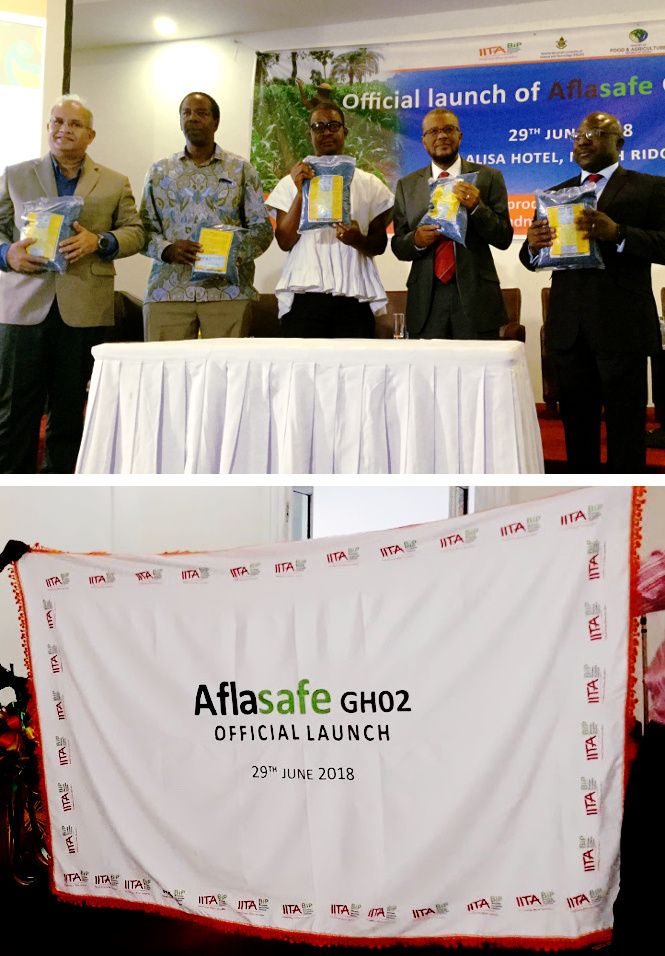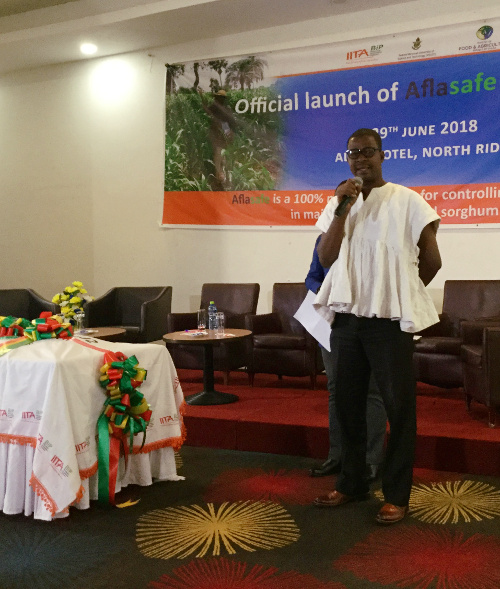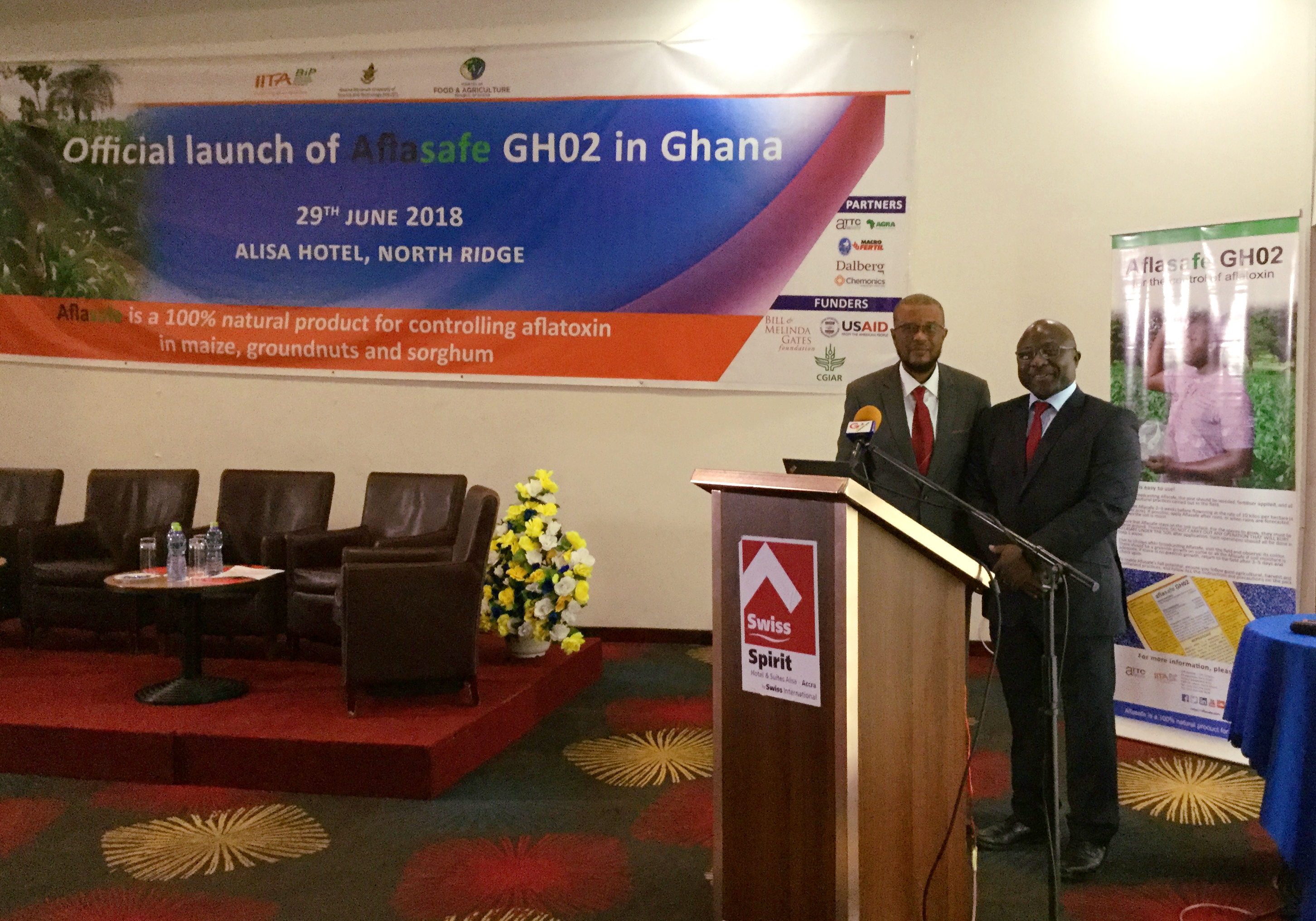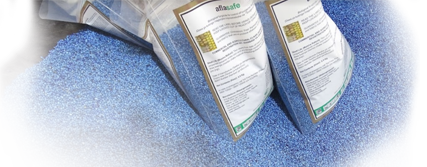Aflatoxin in food is a 44-year-old problem in Ghana. Aflatoxin is furtive – a hidden and silent killer. Aflasafe GH02 reduces aflatoxin by up to 100%.

ACCRA, GHANA, 29TH JUNE 2018 – With the official launch of Aflasafe GH02 in Accra today, Ghana joins the growing list of countries in Africa actively combating aflatoxin in food. Aflasafe GH02 is a product of, from, and for Ghana. An environmentally friendly all-natural solution to the scourge of aflatoxin, Aflasafe GH02 is formulated from four friendly fungi, all from Ghana.
Aflatoxin takes a heavy but hidden toll in Ghana, as elsewhere in Africa where people primarily eat – and depend upon – maize and groundnuts. These two crops, staples on many tables, are also the most vulnerable to aflatoxin contamination. The crunch is that aflatoxin is difficult to detect even when at lethal levels. Measured in parts per billion (ppb), this naturally occurring poison is tasteless, odourless and invisible to the naked eye: one ppb is akin to a single drop of water in an Olympic-size swimming pool.
Despite its invisibility, aflatoxin not a new topic in Ghana: it hogged the headlines in August–September 1998, sparking heated debate on kenkey causing cancer. This shone the spotlight on aflatoxin in food, leading to surveillance studies in maize and groundnuts, and products made from them. Some of these studies revealed levels approaching 4,800 ppb – far above the safety thresholds set by the Ghana Standards Authority of 15 ppb for maize and 20 ppb for groundnuts. These alarming levels clearly demonstrate that a majority of Ghanaians are unknowingly exposed to unsafe aflatoxin levels in the food they eat.
But Ghana is not alone. Aflatoxin is the culprit in at least 30% of liver cancers in Africa. The continent loses hundreds of millions of dollars each year in foregone export opportunities due to aflatoxin contamination.
What is singular about Ghana is how long the problem of aflatoxin in food has been known. “Aflatoxin was discovered in 1960 in the UK and the first published report from Ghana was in 1964,” revealed Prof Richard T Awuah of the Kwame Nkrumah University of Science and Technology (KNUST), in the keynote address. “Whether or not the product will be successful in Ghana will also depend in part on the publicity and perceptions we Ghanaians give it.” Clarifying that Aflasafe was not a genetically modified organism (GMO), Prof Awuah stressed the crucial role of the government and the media in shaping public perceptions and in creating awareness. He was closely involved in the development of Aflasafe GH02.

Representing the Minister for Food and Agriculture, Dr Owusu Afriyie Akoto, Mr Harry Bleppony, the Deputy Director of Crop Services in the Ministry of Food and Agriculture (MoFA), clarified that there was no lack of policies on aflatoxin. But he decried the lack of awareness on aflatoxin, particularly at the grassroots, and the need for evidence-based information. “When people see how hard aflatoxin hits them, they will take it seriously. Aflatoxin is a ‘slow poison’ – language that Ghanaians understand well. Aflasafe GH02 will be a big relief for Ghana’s food chain.”
Other senior officials who were also panel discussants included Mr Erasmus Ashun, Director for Agricultural Export Development at the Ghana Export Promotion Authority; Mr Roderick Dadey-Adjei, Head, Agro Products and Biosafety, Food and Drugs Authority; Mr Yusuf Dramani, Agri Supplier Development Agronomist for Nestlé, Central and West Africa; Mrs Janet Botwe, Head of the Food Crops Unit and Desk Officer for Cereals, MOFA; Mr Samuel Sey, Executive Secretary, Mr Masara N’arziki Maize Farmers Association; and Dr Rose Omari, Senior researcher at the Science and Technology Policy Research Institute (STEPRI).

Applied whilst the crops are still in the field, Aflasafe‘s four friendly fungi displace the aflatoxin-producing moulds in the field by simply first occupying and ‘colonising’ the space these poison-producers would otherwise occupy. Aflasafe was developed by the International Institute of Tropical Agriculture (IITA), in collaboration with the United States Department of Agriculture – Agricultural Research Service (USDA–ARS) and KNUST.
When properly used, Aflasafe prevents crop infection and contamination, reducing aflatoxins by between 80% and 100% in maize, groundnuts and sorghum. With just 4 kilos of Aflasafe, a farmer can effectively protect an entire acre of maize, groundnuts or sorghum, and thereby meet stringent international and domestic aflatoxin standards. The result is more income for farmers, and better consumer health for all.
It has been a diligent journey to Aflasafe GH02 in both laboratory and field. In 2015 and 2016, the product was independently evaluated in more than 100 maize and groundnut fields in several districts in the Ashanti, Brong-Ahafo, Northern, Upper East and Upper West Regions.

The results? All the crops from Aflasafe-treated fields were aflatoxin-safe, with an extremely low range falling between zero and 15 ppb. This stood in stark contrast with crops from non-treated fields, whose aflatoxin content ranged between 8 and 939 ppb. The Aflasafe-treated crops met the standards of both local and international premium markets. Large-scale use throughout Ghana would see farmers produce aflatoxin-safe food, and thereby see all Ghanaians win, given the attendant benefits on health and potential wealth.
Approved by Ghana’s Environmental Protection Agency earlier this year, Aflasafe GH02 is now available in the country distributed by Macrofertil.
Currently, Aflasafe GH02 is being manufactured at IITA headquarters at Ibadan, Nigeria, from where it is imported into Ghana. “We are discussing with companies interested in local manufacture in Ghana,” revealed Mr Abdou Konlambigue, Managing Director of IITA’s Aflasafe Technology Transfer and Commercialisation initiative (ATTC). Aflasafe is also available in five other countries in Africa to date.
Media inquiries: Njeri Okono, Communications Specialist, Aflasafe Technology Transfer and Commercialisation initiative (ATTC)
LINKS
- Combating deadly aflatoxin in Ghana’s food, the Aflasafe GH02 solution, news feature published in The Graphic, 25th June 2018
- How to use Aflasafe GH02 – Text leaflet | Pictorial pamphlet
- The road behind us, pre-launch
- Aflasafe and aflatoxin – downloadable Q&A
- Aflasafe in Africa | Commercialising Aflasafe in Africa
- African food exports: Why a Ghanaian in the UK lost a lot of business in Africa Business Jumpstart
- 2016 import border rejections, a pdf from the INC International Nut and Dried Fruit Council showing rejection of Ghanaian products
About ATTC: The Aflasafe Technology Transfer and Commercialisation initiative (ATTC) implemented by IITA, identifies strategic options for partnership with private companies or government entities, executes those partnerships, and helps ensure the distinct Aflasafe products reach millions of farmers. The initiative will contribute to improved food safety and increased income for smallholder African farmers through using Aflasafe. ATTC’s target is to cover half-a-million smallholder hectares with Aflasafe in 11 countries where Aflasafe is − or is likely to soon be − a nationally registered product. These are Nigeria, Kenya, Senegal, The Gambia, Burkina Faso, Ghana, Malawi, Mozambique, Tanzania, Uganda and Zambia. ATTC’s activities are geared to increase Aflasafe’s availability and accessibility, and to improve access to lucrative aflatoxin-conscious markets for maize and groundnuts. Download ATTC brochure
About KNUST: The Kwame Nkrumah University of Science and Technology (KNUST) aspires to be globally recognised as the premier centre of excellence in Africa for teaching in science and technology for development, producing high-calibre graduates with knowledge and expertise to support the industrial and socio-economic development of Ghana and Africa. Its aim is to advance knowledge in science and technology for sustainable development in Africa. KNUST provides an environment for teaching, research and entrepreneurship training in science and technology for the industrial and socio-economic development of Ghana, Africa and other nations. KNUST also offers community service, is open to all the people of Ghana and positioned to attract scholars, industrialists and entrepreneurs from Africa and the rest of the international community.











One Reply to “Ghana guns for gold in food-safety goal, using Aflasafe GH02 to fight aflatoxin in food”